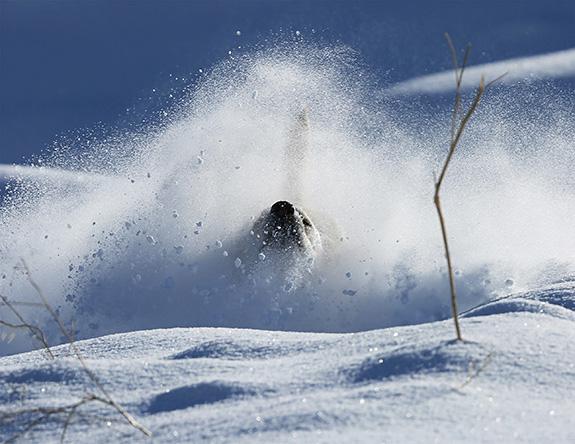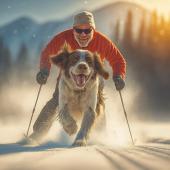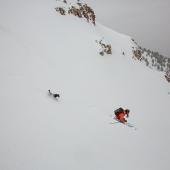Keeping your pooch safe this season.
Winter’s here and we’re scrambling to find ways to keep our pups exercised and happy, even in the cold and snow. Rather than tell you what NOT to do, here’s advice on how to be active and safe. Your pet may have individual limitations, but these are good general tips to follow.
1. Choose activities appropriate for your pet’s breed, age, temperament, and level of fitness. Err on the side of caution, start slow, and build up to higher exertion levels. Most dogs can withstand snowshoeing for an hour; most can’t backcountry ski with your bros all weekend. In general, we see the worst/most expensive injuries from skiing. I wouldn’t ski with my own dog due to the high likelihood of injury. If you’re going to get rad, consider leaving Bridger in the cabin.
2. Develop a plan for travel distance and length of time outside—and stick to it. Remember that you have insulation and gear that your pup doesn’t. Check ears, toes, nose, tail, and genitals (yes) for color changes, texture changes, and pain or apparent numbness. Get inside before frostbite is a concern, and if it’s too late, warm up the tissue slowly with your hands and drive to the veterinarian immediately.
3. Invest in the proper gear. Use booties when it’s very cold, wet, icy/rough, or if snow is balling in the toes and causing discomfort. Even if your dog doesn’t appear to like them, always carry booties in case of injuries that affect your dog’s ability to walk. Musher’s wax and other pad products help hair and skin repel water and ice balls, and are available locally.
4. Assemble a first-aid kit and take it on every trip. Include medications like famotidine (Pepcid AC) 10mg tablets, diphenhydramine (Benadryl) 25mg tablets, a dog/cat specific NSAID or other pain medication (from your vet—NOT ibuprofen), and 1-2 extra doses of any chronic medication your pet takes. Bring “non-adherent” wound-covering dressing (Telfa) pads, cast padding, and VetWrap/Coban. Bring extra water and food. Talk with your vet before your trip about how/when to use these items and remember that a bandage buys time to get to the vet, but is probably too tight to leave on for more than an hour or two.
5. Last but not least, ask your vet! We’ll help identify considerations for your specific pet and the activity you have planned. We may sound like Negative Nancys sometimes, but we just want you and your pet to enjoy an active lifestyle as much as possible—without emergency visits to see us.
Michelle Pogge has been a veterinarian in the Gallatin Valley for seven years and currently works at Gallatin Veterinary Hospital.





